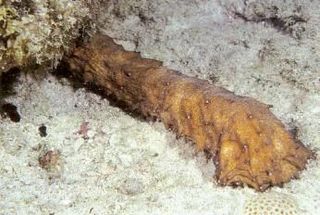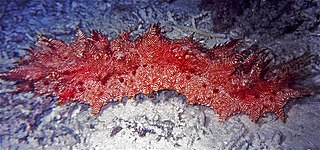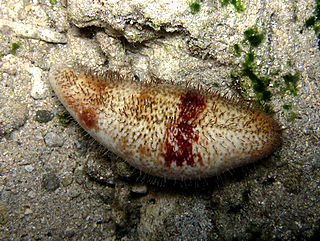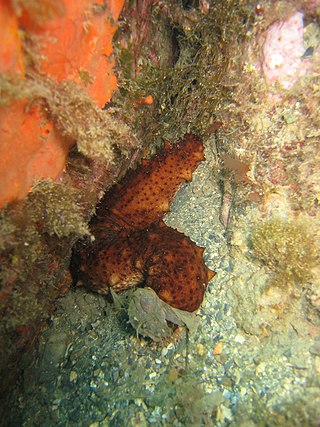
Sea cucumbers are echinoderms from the class Holothuroidea. They are marine animals with a leathery skin and an elongated body containing a single, branched gonad. Sea cucumbers are found on the sea floor worldwide. The number of known holothurian species worldwide is about 1,786, with the greatest number being in the Asia-Pacific region. Many of these are gathered for human consumption and some species are cultivated in aquaculture systems. The harvested product is variously referred to as trepang, namako, bêche-de-mer, or balate. Sea cucumbers serve a useful role in the marine ecosystem as they help recycle nutrients, breaking down detritus and other organic matter, after which bacteria can continue the decomposition process.

Holothuriidae is a family of sea cucumbers, a type of echinoderm.

Holothuria scabra, or sandfish, is a species of sea cucumber in the family Holothuriidae. It was placed in the subgenus Metriatyla by Rowe in 1969 and is the type species of the subgenus. Sandfish are harvested and processed into "beche-de-mer" and eaten in China and other Pacific coastal communities.

Holothuria thomasi, the tiger's tail, is a species of sea cucumber in the family Holothuriidae. Although it is the largest sea cucumber known in the western Atlantic Ocean, it is so well camouflaged that it was 1980 before it was first described. It is placed in the subgenus Thymiosycia making its full name Holothuria (Thymiosycia) thomasi.

Holothuria leucospilota, commonly known as the black sea cucumber or black tarzan, is a species of marine invertebrate in the family Holothuriidae. It is placed in the subgenus Mertensiothuria making its full scientific name Holothuria (Mertensiothuria) leucospilota. It is the type species of the subgenus and is found on the seabed in shallow water in the Indo-Pacific.

Halichoeres prosopeion, commonly called the twotone wrasse, half-grey wrasse or zig-zag wrasse, is a fish species in the wrasse family native to the western Pacific Ocean.

Actinopyga echinites, commonly known as the brownfish or deep water redfish, is a species of sea cucumber in the family Holothuriidae. It is native to the tropical Indo-Pacific region and is harvested for food.

Thelenota rubralineata is a species of sea cucumber in the family Stichopodidae, in the phylum Echinodermata, mainly located in the central Indo-Pacific region. It has a distinctive coloring pattern, and can be found on the seabed near coral. T. rubralineata is part of the Thelenota genus, characterized by their large size and the presence of a calcareous ring.

Holothuria fuscopunctata, the elephant trunkfish, is a species of sea cucumber in the family Holothuriidae native to shallow water in the tropical Indo-Pacific. It is placed in the subgenus Microthele, making its full name Holothuria (Microthele) fuscopunctata.

Stichopus herrmanni, or Herrmann's sea cucumber, is a species of holothuroidean echinoderm in the family Stichopodidae. It is found in the tropical, western Indo-Pacific Ocean, at depths down to 20 m (66 ft). This and several other species are known as curryfish and are harvested commercially; it is called gama in Indonesia.

Actinopyga mauritiana, commonly known as the surf redfish, is a species of sea cucumber in the family Holothuriidae. It is native to the tropical West Indo-Pacific region and is harvested for food.

Labidodemas rugosum is a species of sea cucumber in the family Holothuriidae. It is native to the tropical Indo-Pacific region.

Actinopyga miliaris, commonly known as the hairy blackfish, is a species of sea cucumber in the family Holothuriidae. It is native to the tropical West Indo-Pacific region and is harvested for food.

Actinopyga lecanora, commonly known as the white-bottomed sea cucumber or stonefish, is a species of sea cucumber in the family Holothuriidae. It is native to the tropical Western Indo-Pacific region and is harvested for food.

Actinopyga capillata, the hairy sea cucumber, is a species of sea cucumber in the family Holothuriidae. It is found in the tropical West Indo-Pacific region, having a disjunct range, with the main population in island groups in the western Indian Ocean, and a separate population in the Philippines.

Actinopyga varians, the Pacific white-spotted sea cucumber or Hawaiian sea cucumber, is a species of sea cucumber in the family Holothuriidae. It is found in the Pacific Ocean near Hawaii and also in the Indo-Pacific Ocean.

Pleurosicya mossambica, also known as the toothy goby or the Mozambique ghost goby, is a small species of goby native to the tropical Indo-West Pacific region. It was first described by South African ichthyologist J.L.B. Smith in 1959. Like many other gobies, it forms commensal relationships with several other marine invertebrates, including soft corals and sponges.

Holothuria stellati, also known as the brown sea cucumber,is a species of sea cucumber in the family Holothuriidae. First described by Delle Chiaje in 1824. There are two accepted subspecies, Holothuria stellatidakarensis and Holothuria stellati mammata, though there is still debate on whether or not they are separate species.
Holothuria (Cystipus) cubana is a species of sea cucumber in the family Holothuriidae. This species was first described by Ludwig in 1875.
Actinopyga palauensis, the Panning's blackfish, is a species of sea cucumber within the family Holothuriidae. The species distribution is in the western Pacific near areas such as Palau, the Federated States of Micronesia, Tonga, Niue, eastern Australia, and New Caledonia. It lives in reef environments at depths up to 30 meters, often being found crawling on sandy reef slopes, course sand with reef rubble, semi-sheltered bay reefs, and is occasionally found in lagoons and inshore reefs.



















